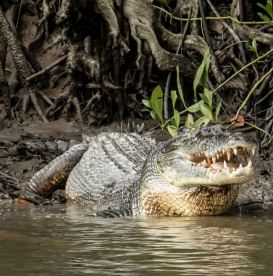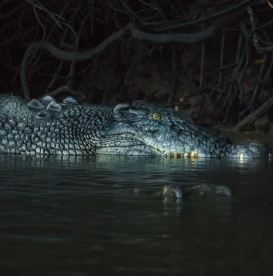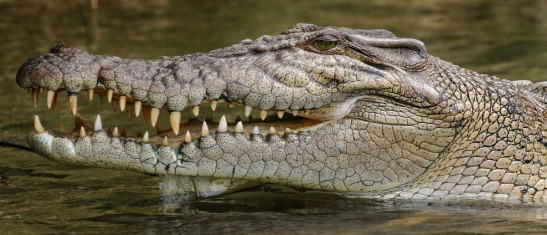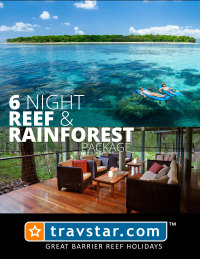THE SALTWATER CROCODILE
Saltwater crocodiles are not only found in Saltwater as the name suggests. They are frequently found in major creeks and foreshores of the tropical north...
There are two species of crocodiles in Australia, the Saltwater and Freshwater species, and only the "salties" inhabit the Daintree River. It's scientific name is Crocodylus Porosus and its habitat ranges throughout the Indo Pacific regions.
Although history suggests the animals to be very big, the largest crocodiles seen in Australia these days would probably be between 5-6 metres. The Daintree River has a population of about 70 adult crocodiles, the largest being the males at about 5 metres. The females reach about 3.5 metres, and there are many juveniles and hatchlings.
In the last 20 years the Daintree has become well-known for its success in crocodile-spotting.
There is a great fascination for these animals, particularly with the tourists who visit us from all over the world. Crocodile spotting in this region has only become popular since about the mid 70's and visitors are impressed with the opportunity to see the crocodiles from nearby. The animals have become used to the boats and by leaving their engines running, or idling, cruise boat operators can get a close look from about 10-15 metres.
The population is described by the experts as being of a low density, and that is because of prolonged hunting over many years. By 1974 the numbers were dangerously low and legislation was introduced to protect them. The numbers have come back slightly to the present sustainable level and they are still breeding successfully.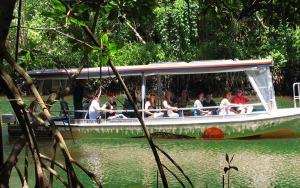
They breed during the summer by laying many eggs in a large composting mound which they construct. The eggs are incubated for 3 months until they hatch during the Wet season. There is about a 30% hatching rate.
The hatchlings are 20cm long and stay with the female for several weeks or months before dispersing. If one or two survive, nature has been successful.
Some of the predators include goannas (monitors) which will dig into the nest to take the eggs, while fish, sharks and birds attack the hatchlings. For safety while fishing, hatchlings move along the edges in the shallows catching prawns, crabs and small fish. The larger crocs have a staple diet of fish and crabs although they are opportunistic and are great scavengers.
The best time to spot crocs are the cooler winter months. The wet season temperatures are usually too hot so the crocodiles submerge to the river bottom
CASSOWARY
The Daintree rainforest is a critical habitat and a 'hot spot' for the Southern Cassowary which is classified as an endangered species...
Rainforests would be a very different place with diminished diversity if there were no cassowaries. These huge birds are the only animals capable of distributing the seeds of more than 70 species of trees whose fruit is too large for any other forest dwelling animal to eat and relocate.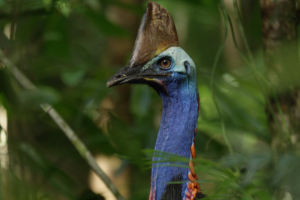
Cassowaries can grow up to two metres tall and weigh 85 kilograms. The cassowary’s feet have three large toes, with a spike on each foot up to 120mm long and can run up to 50 km/hr. They have a striking blue head with bright red wattles, and a glossy black coat.
The female cassowary is larger and more attractive than the male.
Chicks have cream and black stripes when they hatch. From six months of age, they turn dark brown and, by about four years, they have turned black, like their parents.
The female cassowary has turned the tables on what is mostly a maternal social structure in the animal world. The males incubate the eggs and raise the chicks. Once a clutch of eggs is laid, the female will seek out other males with which to mate. For each male that she finds, she will provide a clutch of eggs (usually 3 to 5) for him to nuture.
The cassowary is flightless and is normally quite shy. However, if the bird is agitated in any way – such as being cornered in a small area, or if any animal including human approaches it’s nest – it will lash out violently with its sharp claws.
Serious injury can result, so avoidance of these large birds is recommended. If you see a cassowary, do not turn and run away from it. Instead, face the bird and back away slowly. Do not feed the cassowary either. (See Useful Info)
Look for signs such as large dung piles scattered on the rainforest floor, and the unmistakable three-toed footprint (up to 180mm).
CASSOWARY CORRIDORS
The Discovery Centre is in the middle of a 'Cassowary Corridor' and it's a good place to start if you want to see a cassowary in its natural habitat. We often see a gigantic female wandering along the creek in search of fallen fruit, and our 'resident' male with a clutch of chicks in tow. However, the staff at the Centre are careful to ensure no one feeds them.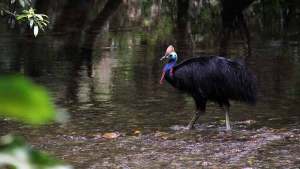
Cassowaries are territorial and the juveniles' survival depends on establishing a 'home range' of their own. This is a gradual process of acquisition by increments. Most juveniles are familiar with the parent's routine and you will often spot a newly evicted bird shadowing an adult or sneaking into a popular feeding ground just before the parent arrives.
As the courting period nears, the adults become intolerent of juveniles so keeping out of their parents' way avoids unnecessary conflict. It can be difficult to tell the sex of a cassowary as their colouration is identical. Courtship is one of the few times the difference is obvious - the females being markedly larger than the males. When you see an adult with young its invariably a male.
The father incubates the eggs and will raise the young for 6-9 months, but it can be longer. At the Discovery Centre we observed the 'resident' male looking after his three chicks nearly 15 months. When very young, the chicks would constantly whistle to stay in close contact, and panic if they lost sight of the group. As they matured they became more adventurous; no longer hurrying to catch up with Dad each time he moved away, but pausing to drink from the creek or take a quick dip.
I remember when a chick became seperated from the group. The distressed father kept calling out and marching back and forth until the wayward chick stumbled over the rise, to be safely reunited with Dad and siblings.
It amazes me that the male cassowary can suddenly change from this careful, caring parent to become cantankerous once the breeding season approaches. You can imagine how very proud we were when our 'resident Dad' skipped one whole breeding cycle in order to care for his chicks into their second year.
Although it is not unknown for chicks to stay with their father up to 20 months, it is unusual. There are often practical explanations - the fruiting season may have been poor and the chicks' development was slower than normal; the adult male may have been inexperienced; or he may not have found a suitable breeding female.
There is so much that is not understood about these magnificent birds and I am continually reminding people that there is a whole world of information out there waiting to be gathered. Despite a wealth of scientific data, the Daintree still holds most of its ancient secrets.
Alan Curtis has been a senior guide at the Daintree Discovery Centre for the past 10 years.
Information kindly supplied by the Daintree Discovery Centre.
FERNS OF THE DAINTREE
While many of the plants in the rainforest have been around for millions of years, ferns have been around for much longer than that!
The Daintree/Cape Tribulation region is home to over 3,000 plant species including trees, vines, palms, ferns, epiphytes, as well as the world's largest and smallest tree ferns and cycads. Unknown plants and animal species are still being discovered.
Daintree National Park has examples of the most primitive plants and animals in the world, representing major stages in the earth’s evolutionary history. 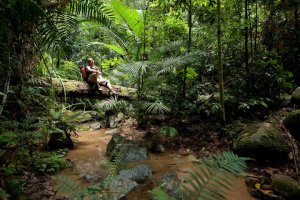
For example, 13 of the world’s 19 primitive flowering plant families are found within the Daintree National Park, as well as the world’s most primitive pines, cycads, ferns and mosses. Many of these ancient plants provide an insight into the evolution of flowering plants, which began about 120 million years ago.
Ferns first appeared in the fossil record dating back to 325 million years ago. They are one of the earliest vascular plant forms on the planet (plants which circulate water internally) and they preceded the flowering plants, the conifers and even the cycads - all of which have a more advanced means of reproduction.
40 species of ferns are endemic to the Wet Tropics (occur nowhere else) and there are many interesting species but only a few special ones are profiled here.
Rainforest Rescue has recently purchased a sixth property in the Daintree Buy Back and Protect Forever Project which has saved the world’s only known site, at the time of purchase, of a species of the Filmy Fern new to science.
The Filmy Fern was first discovered in 1954 however the site was lost or destroyed and it was not rediscovered until 1998. The new site of the fern was however on a freehold property threatened with residential development.
The purchase of the property in the Cow bay area of the Daintree has saved the site, however adjacent properties may still be developed increasing the risk of visitation and damage to the fern.
MANGROVES
Mangroves are what we call the collection of salt tolerant plants that are found along sheltered shorelines and in the saline reaches of rivers along the length of the Great Barrier Reef.
Mangrove forests occupy approximately 2070 km2 spread along the length of the coast adjacent to the Great Barrier Reef World Heritage Area. 
About 95 per cent of this forest is on the border of the World Heritage Area, not actually inside it. However, all mangrove forests within and adjacent to the World Heritage Area are interconnected with, and form a critical part of, the Great Barrier Reef ecosystem.
Mangroves within and bordering the Great Barrier Reef Marine Park are some of the most pristine and diverse mangrove forests in the world. There are 34 species of mangroves in Queensland with a total of only 69 species worldwide.
These salt tolerant plants have adapted for where they live. Each high tide, the sea floods their roots and trunks. The mangroves have a number of different systems to handle all this salt:
Their roots can prevent its absorption by filtering it out
They can concentrate the salt in older leaves which fall off, taking their accumulated salt with them
Some species have salt glands which actually excrete the salt onto the surface of the leaves where it is washed away by the rain.
Boardwalks have been installed at several locations in the Wet Tropics area and this makes a wander through the mangrove forest enjoyable and easy - but don't forget your insect repellent!
FROGS
Tropical North Queensland is a very special area for frogs... 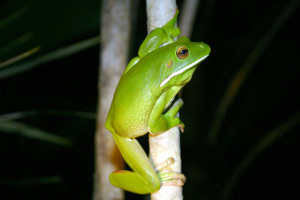
The Wet Tropics area alone is home to about 54 species of frogs. More than 20 species are found in the rainforests and no where else.
Representatives of all five Australian frog families are found in the area. Some limited to very small areas such as The Thronton Peak tree frog which apparently occurs only above 640m on Thornton Peak.
One of the world's favourite frogs is the Common Green Tree frog, which is called White's Tree frog in the USA. Even as an adult of 90mm (3 ½ inches) in size, the Green Tree frog always retains its gentle baby face.
It is probably the most commonly kept frog in Australia and has been kept for decades overseas.
It is often found around houses, especially in outdoor loos (bathrooms) and in gutter pipes. Sometimes these frogs are found in mailboxes and moved, only to be found in the same mailbox a few days later. Green Tree Frogs actually have a 'homing instinct'.
Like all rainforest creatures frogs are an integral part of the ecosystem - eating and being eaten by a variety of other animals.
Frogs are especially vulnerable to such things as pollution, insecticides, herbecides etc as they absorb moisture through their skin. Consequently, they are widely recognised as a 'barometer' for the well being of our environment.
BIRDS OF THE DAINTREE
Birdwatchers flock to the canopy...
The Wet Tropics of NQ are well known for many reasons including their World Heritage status - which they share with the Great Barrier Reef. To the growing international birding fraternity the area is also renowned for the outstanding opportunities it offers to locate, in order of, 60% of Australia's bird species.
The Wet Tropics encompasses the meeting point of three major Australian bird distribution areas, the Northern, Eastern and North Qld region. Best known in tourism advertising for its luxuriant rainforest, it is also remarkable for its close proximity to many other habitats - all within an hour's drive. Away from the Coral Sea, and beyond the Great Dividing Range, we have the Savannah Woodland, highland Eucalypt Forest and wetland areas.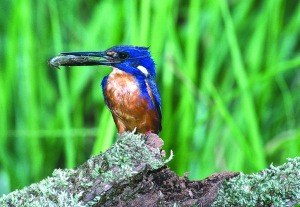
The diversity of the local birdlife in the Daintree is extraordinary but the iconic species would be the Southern Cassowary, a denison of the rainforest. Despite its vibrant neck colours and large size, its dark plumage makes it difficult to spot unless its on the move. An an endangered species, these magnificent birds are easily overlooked.
The Daintree Rainforest is very dense and this offers a challenge when looking for local wildlife. However, patience and persistence will be amply reawarded. Colourful birds include the Fruit-doves and parrots which follow the never ending sequence of fruit and flower.
Endemic species include bowerbirds, honeyeaters, riflebirds, flycatchers and scrubwrens. These are complimented in spring and summer by visitors from Asia and Papua New Guinea which arrive from September to November to breed. Prehaps the most spectacular bird is the Buff-breasted Paradise-kingfisher which nests in terrestrail termite mounds. Though very colouful it can be frustrating to observe until March when they are nuturing their free flying young.
With its Arial Walkway and Canopy Tower, the Daintree Discovery Centre offers an excellent opportunity for visitors to spot elusive rainforest birds at every level of the rainforest. But it would be remiss of me not to mention the Daintree River. Local guides maintain a very broad interest in all aspects of the riverine environment, from mangroves to birdlife.
There are many types of eco-tours that visit the Daintree Rainforest, from large groups to sole charters. There are also a number of specialist birding guides throughout the area catering for various sized groups, as well as self drive visitors, and I would encourage visitors to research the wide range of options available beforehand. This will ensure maximum benefit from, and enhance their experience in this very special part of the world.
Del Richards, Fine Feather Tours
Information kindly supplied by Daintree Discovery Centre
BUTTERFLIES
Extract from "Daintree - Jewel of Tropical North Queensland" by Lloyd Nielsen.
There are many colourful butterflies about the Daintree rainforest - triangles, leafwings, swallow-tails, sword-tails, cruisers, jezabels, blues and others.
The sunny edges of rainforest where shrubs are in flower often attract butterflies in numbers, particularly where the introduced lantana invades the perimeter. Here butterflies visit flower after flower, systematically searching for nectar.
Like some of the colourful birds though, bright colours of many butterflies blend with the rainforest. Most butterflies are unobtrusive, flying only in bright sunny weather.
The huge and beautiful Ulysses Butterfly however, is obvious, and often seen about the warm lowland rainforests of the Daintree. Brilliant metallic blue wings resemble an intense blue flashing light as the butterfly flies rapidly about open spaces against a background of green foliage.
Often symbolised in promotional material in the tourism industry, it is as evocative to these northern rainforests as the Southern Cassowary or the Fan Palm.
You may also be fortunate enough to see the large green, gold and black male Birdwing butterfly about the rainforest edges or clearings.
With a slower, more relaxed flight than the Ulysses, it resembles a large leaf aloft on the breeze. The female is sombre in black and white with touches of yellow and red. With a wingspan of about 20 centimetres she is Australia’s largest butterfly.
SNAKES IN THE DAINTREE
Snakes, this word sends shivers up the spines of a lot of people and most think of the venomous species, there are four main ones found in the Daintree, the Taipan, the Eastern Brown, the Death Adder and the Red-bellied Black. All of these snakes are dangerous to man and should be avoided at all times. If one does encounter a snake just walk slowly away in the other direction.
Most of the snakes seen in the Rainforest are harmless though some do obtain very large lengths. The Amethystine Python, also commonly called the Scrub Python, can often be seen sun baking in the tree tops. This large python has been know to grow to 6 metres but normally between 3.5 to 4 metres is average length.
The Carpet Python also can be found and its colour varies a lot, the Jungle Carpet is a very striking colour being black with bright yellow markings. Water Pythons, Spotted Pythons, Slatey Grey Snakes, Freshwater Snakes, Tree Snakes, can also be observed just to name a few.
Winter enhances your chances of seeing snakes as they seek out open, sunny areas. However, they are usually trying to get away from you, so simple awareness is the key to avoiding contact with snakes.
Extract from Article written by Tony Gordon, curator of Daintree Mangroves Wildlife Sanctuary.
SPIDERS
"Some of the creatures of the forest are so well-camouflaged that they are hard to see, even when you know they are there."
You will be relieved to hear that the only two species of poisonous spiders in Australia, the funnelweb and redback, do not live in the rainforest!
As a newcomer to the rainforest you will see trees, a great many of incredible diversity, but if you look closer you will see another world of intricate and secretive wildlife.
The Wolf Spider, for example, is the most commonly sighted spider in the Daintree. They are often large, open-range hunters that are conspicuous at all heights within the forest by their distinctive eye-shine reflection. Their eyesight is very strong and with eight eyes they can see in three different directions at any one time. Such an advantage serves them well in the three-dimensional habitat of the rainforest and particularly in the upper canopy where insect life is most abundant.
Perhaps the most spectacular of all the Daintree spiders is the Golden Orb-weaving Spider. The largest of the world's master weavers, its unmistakable golden web can exceed one metre in diameter and is strong enough to break the momentum of tiny birds and insectivorous bats.
Golden Orb Web Spiders are very common in the Daintree, especially after some summer rain, and can be seen on Marrdja boardwalk and around the toilets at Cape Tribulation.
The female spiders are the size of a spread hand, but fortunately are a very passive and harmless (to people) species. If you move in for a close look, you will usually see some of the males sharing her web. They are only a millimeter or two in body size, so small that she doesn't even recognise them as worth eating, a good survival strategy for the males.
The golden colour of the leg joints and the bright gold of the circular web account for the name. You should also be able to see how the female holds onto the radii of the web, avoiding the circular strands which are coated with sticky drops. The radii are dry silk without the glue, so she doesn't get stuck on her own web. Very embarrassing when that happens…
UMBRELLA FLOWER
The Umbrella flower belonging to the Umbrella Tree, is native to our tropical rainforests in Australia .This spectacular species can be found particularly in eastern Queensland and the Northern Territory. The plant produces up to 1000 flowers, generating large amounts of nectar which attracts honey-eating birds (pictured) which then spreads the seeds. The fruits are also eaten by many other animals including Musky Rat Kangaroo, Red-legged Pademelons and the Spectacle Flying Fox . Its leaves are also a favorite food of the Bennett Tree Kangaroo. This beautiful species are a common site on all our full day tours.




